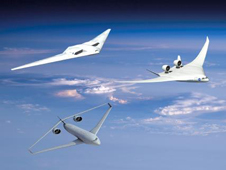Aeronautics

NASA is performing research to design and make aircraft that are safer, more fuel efficient, quieter and also eco-responsible. These newer and more efficient vehicles are planned to be in-place by the year of 2025. Three industry teams are under a contract to the NASA Aeronautics Research Mission Directorate's Environmentally Responsible Aviation Project.
The three teams are from the Boeing Company located in Huntington Beach, California, Lockheed Martin in Palmdale California, and Northrop Grumman in El Segundo California. These teams have spent the last year searching for a way to accomplish NASA's goals.
NASA's goal is to develop a technology that allows the aircraft burn 50% less fuel and 50% less harmful discharges. Lockheed Martin had their engineers come up with a box wing design. They had been studying this type of design for 30 years but had been waiting for the materials and technologies for this type of structure. Boeing's design used their blended wing body design. This same design had been used in their remotely piloted X-48. Grumman chose a design used by their company back in 1930's and 1940's. This wing design is similar to the one used in their B-2 aircraft.
NASA is also developing flight traffic management systems that are safer, more efficient and flexible. The next generation of Air Transportation System, called NextGen, is to be in place by 2025 and will enable aircraft to climb and descend from their cruising altitude without interruption.
If NASA reaches its goal, it will lower the amount of fuel needed and harm caused to the environment.
← International Space Station Science →
If two pieces of metal touch in space, they become permanently stuck together.